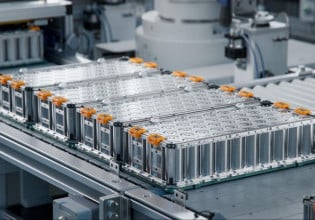The Ins and Outs of Compressed Air Energy Storage
California has partnered with a Canadian company to store excess renewable energy using compressed air in underground caverns.
Wind power and solar energy are two of the most promising forms of renewable, emission-free energy. Both, however, are intermittent and, therefore, require some form of energy storage to supply energy when the resources are less abundant. Lithium-ion battery systems have become the most glamorous method to store energy on a grid scale, but they are not the only way that huge amounts of excess energy can be stored and then returned to the grid as needed.

Pumped storage hydropower. Image used courtesy of Hydrostor
Pumped Storage Hydropower
The reality is that 95 percent of utility-scale energy storage in the U.S. is done by moving water between two reservoirs located at different elevations. Pumped storage hydropower (PSH) uses excess electricity to power pumps that move water from a lower elevation to a higher one. When the energy needs to be recovered, the water flows from the upper reservoir to the lower one through a water wheel that powers a generator that produces electricity. PSH systems can last for decades, and the storage capacity is limited by the size of the reservoirs.
This is also a disadvantage of PSH—the huge amount of land that is needed to make up the reservoirs at different elevations to contain the water.
Compressed Air Energy Storage
Another way to store large amounts of energy is by pumping compressed air into underground caverns. In most cases, the cavern is in an underground salt deposit that can be made reasonably airtight to allow the compressed air to be stored. The salt domes used for this kind of storage are uncommon, so their geographic location is not always optimum for storing lots of energy. There are only two salt-dome compressed air energy storage systems in operation today—one in Germany and the other in Alabama, although several projects are underway in Utah.
Hydrostor, based in Toronto, Canada, has developed a new way of storing compressed air for large-scale energy storage. Instead of counting on a salt dome, the company makes a series of shafts that go several thousand feet underground, miners are then sent underground to hollow out a cavern that can be used for compressed air storage.
Hydrostor has announced a 25-year project with Central Coast Community Energy (3CE), one of California’s largest community choice aggregators that works with local governments, to build a 200 megawatt (MW)/1,600 mega-watt-hour (MWh) underground compressed air energy storage (CAES) facility.
Located in Kern County, California, and scheduled to be completed in 2028, the Willow Rock Energy Storage Center will be the largest CAES facility in the world. The facility will require just 100 acres of land and has an expected life of more than 50 years. The cavern dug by the miners will be 200 meters in length and width and 100 meters high.

Compressed air energy storage. Image used courtesy of Adobe Stock
Compressed Air Energy Storage Challenges
As promising as compressed air appears as a storage medium, it does have some drawbacks. When air is compressed, it heats up. When it expands, it cools. Cold air isn’t as effective at producing power when it is run through a turbine, so before the air can be used, it needs to be heated, frequently using natural gas, which produces CO2 emissions. Hydrostor claims that it has developed a system to capture the heat generated when the air is compressed and reuse it to heat the air when it expands into the turbine used to generate electricity.
Another problem with CAES is that it is much less efficient than battery storage. The round trip of compressing the air, storing it, and then using it to generate electricity is between 60 percent and 65 percent efficient. By comparison, a lithium-ion battery system is in the high 80 percent efficiency range. The CAES can only store energy for about 8 hours, making it useful for short-term storage of large amounts of excess renewable energy on a windy or particularly sunny, but less practical than pumped storage hydropower and even lithium-ion for the long term.
Compressed Air Energy Storage Positives
The plus side of CAES and one reason that 3CE has agreed with Hydrostor is that after more than a decade of falling prices, the cost of lithium-ion batteries and their raw materials has increased. They are willing to make a bet that the low costs and longevity of a CAES system will be a worthwhile investment.






